
18 minute read
VANISHING SOLITUDE
Arches National Park
IMAGINE EDWARD ABBEY’S RESPONSE TO TODAY’S CONJESTED NATIONAL PARKS
Advertisement
BY JOHN RASMUSON
campgrounds and the fact that most of them have never even heard of Arches National Monument.”
But as every sandstone arch attests, change is as inevitable as it is consequential: Pave a road and they will come. The first nine miles of asphalt were laid at Arches in 1957. A visitor center with running water opened in 1969, a year after the publication of Desert Solitaire. By the time Arches became a national park in 1971, more than 200,000 people a year were making the long drive to check it out. The park’s 18-mile loop road was resurfaced in 2017, a boon to the motorized tourists who preferred to see the park’s treasures through the windshield.
Visitors to the park reached the 1 million mark in 2010. Nine E dward Abbey was hired as a seasonal park ranger at Arches National Monument in 1956. He was 29. Part of his job was to man the entry station. It stood alongside a dirt road 20 miles north of Moab, which was “the uranium capital of the world” at the time. On most days, no visitors showed up. By the end of the year, just 28,500 people had navigated rough roads for a look at some of the 2,000 redrock arches they had heard about.
“Motorized tourists stay away by the millions,” Abbey wrote in Desert Solitaire, his classic memoir of the two summers he worked at Arches. “They stay away because of the unpaved entry road, the unflushable toilets in the three “LOOK ON MY WORKS, YE MIGHTY, AND DESPAIR!” —PERCY BYSSHE SHELLEY “OZYMANDIAS”
Supermoon at the Windows in Arches National Park
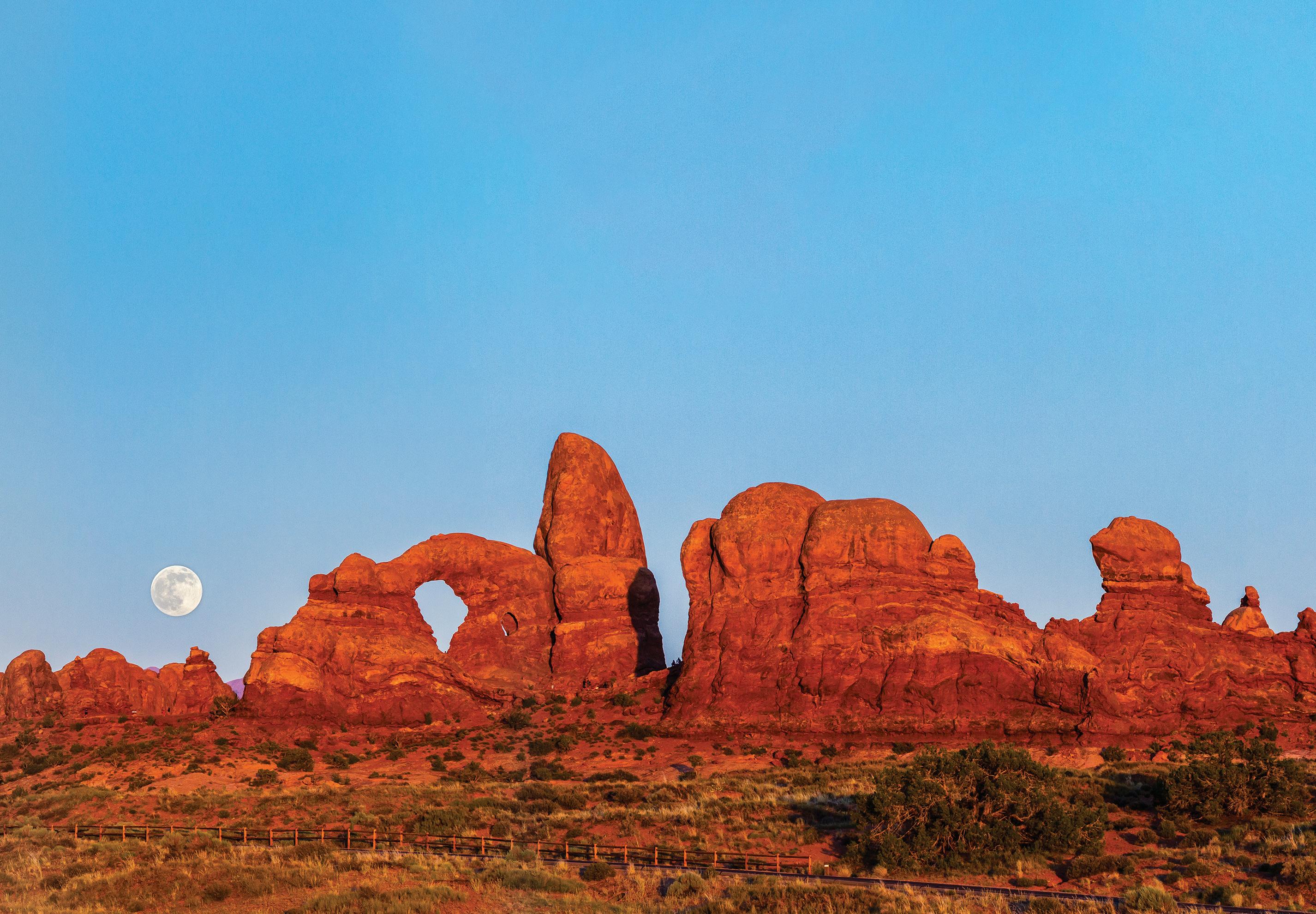
years later, boosted by the Utah Office of Tourism’s Mighty 5 advertising campaign, more than 1.5 million people now visit annually. Some weekends, a line of idling cars back up on U.S. 191 as hundreds of tourists queue at the entrance. On Oct. 18, 2019, at 1 p.m., the National Park Service (NPS) had to close the door. “Arches National Park is currently full,” it tweeted. Abbey, who died in 1989, would have recoiled at motorized tourists gathering like barbarians at the gate. He would have fumed. Then despaired. Then cussed. “Goddamned industrial tourism!” he would have ranted. In his mind, a cabal of car makers, road builders, developers, restaurateurs, hoteliers and gasoline retailers posed an existential threat to the national parks. The car-bound tourists he objectified were at once “the consumers, the raw material and the victims of industrial tourism.”
Abbey would have also disparaged Utah’s tourism office as being a running dog of the soulless industrialists. Its $3 million promotion in 2013—featuring curated images of Arches, Zion, Capitol Reef, Bryce and Canyonlands—included TV commercials in Los Angeles, Denver, Phoenix, Portland, San Francisco and Seattle. Within five years, the number of visitors increased by 68%. To protect Arches’ fragile landscape from the onslaught, Abbey advocated a ban on cars and a repurposed NPS to deliver the backpacks of walkers and cyclists to campgrounds. The radical plan won’t be adopted anytime soon, but the need to manage the growing, peak-season crowds is urgent. The NPS at Arches borrowed on the experience at Maine’s Acadia National Park to propose a reservation system and 2,000-carsa-day limit between March and October. The proposal was met with brickbats. Should vehicle-entry reservations be required, critics said, the annual cost in lost tourist dollars would exceed $20 million. The NPS quickly withdrew the proposal and took up a study of mandatory shuttles and a second entrance to the park.
At the launch of the Mighty 5 campaign, Utah Gov. Gary Herbert said, “Utah’s five stunning national parks contribute to Utah’s economy in a meaningful way by creating much-needed jobs and impacting local economies in gateway communities and surrounding areas.”
Herbert, whose lack of support of Bears Ears and Grand Staircase-Escalante national monuments caused the Outdoor Retail Association to take its business to Denver, made no mention of Abbey’s assertion that “wilderness is not a luxury
but a necessity of the human spirit and as vital to our lives as water.” Neither did it come up in a recent letter to the secretary of the interior from the Utah congressional delegation about crowd management at Zion National Park. With its 4-million-plus visitors a year, Zion is one of the busiest parks in the country and “a pillar of the local tourism economy, helping support jobs and generate revenue.” The letter, signed by Utah senators Lee and Romney and four congressmen, expressed “strong opposition to any reservation system” because it would “likely result in reduced visitation and negative economic impact,” they wrote. “We strongly urge the department to find solutions that will preserve access to Zion National Park while enhancing the visitor experience.” Abbey would have scoffed at the mere mention of unrestricted crowds enhancing a wilderness experience. Where is the point of diminishing returns? he would ask. Five million visitors annually at Zion? Three thousand cars a day at Arches? At what point do parking hassles, toilet lines and congested trails dominate the memory of a sunset hike to Delicate Arch? How crowded does it have to get before visitors simply go elsewhere?
Motorists no longer stay away by the millions as they did in Abbey’s day. The Mighty 5 promotion has been mighty successful, no question about it; and no question that politicians side with the moneyed interests of industrial tourism. The nascent interest in building a second entry to Arches found a voice in the 2020 legislative session. Proposed by Rep. Steve Eliason, R-Sandy, a new state park, named for the Utahraptor dinosaur, is configured such that access to Arches is possible. An investment of $10 million would fund roads, parking lots and restrooms on a 6,500-acre site
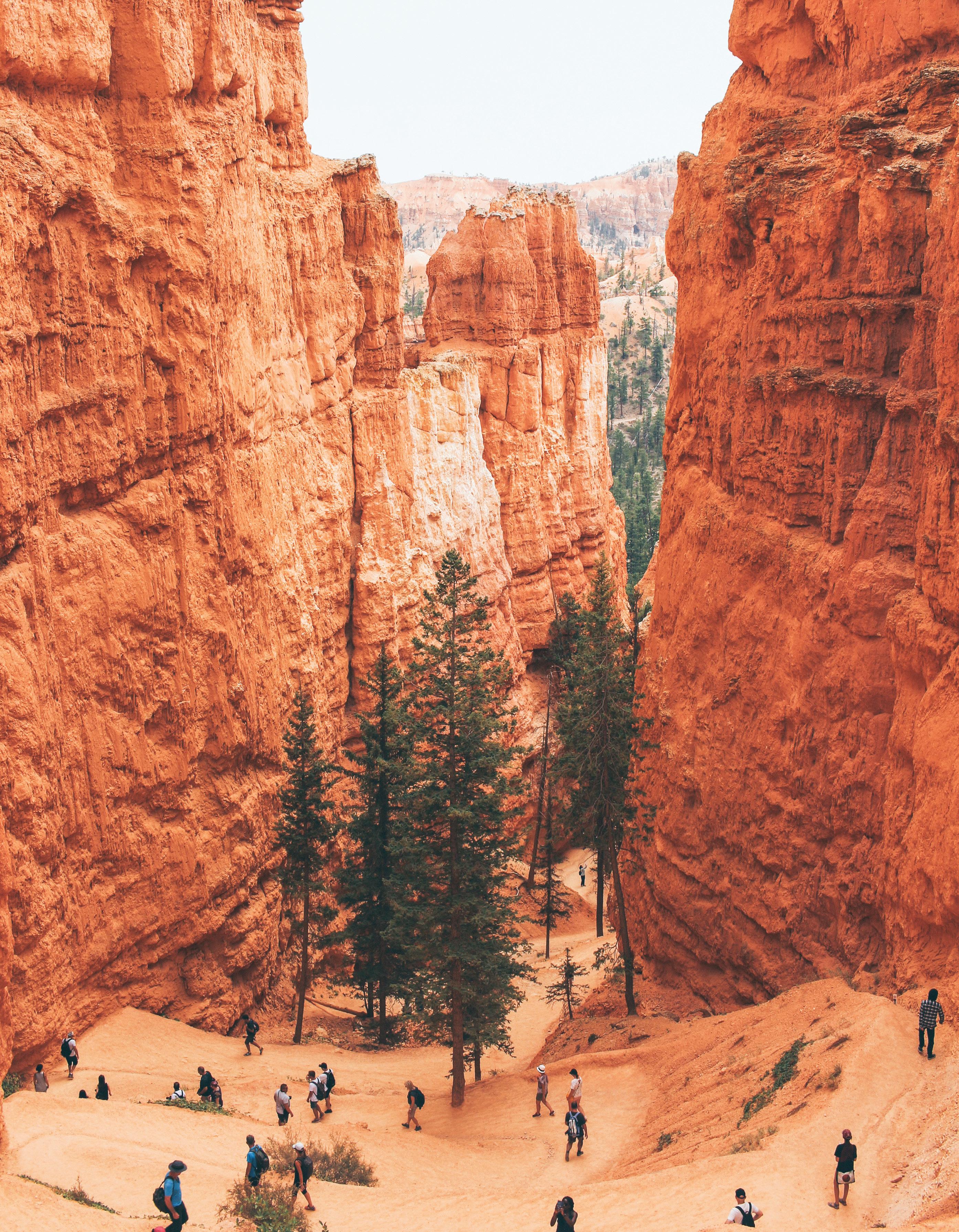
straddling U.S. 191, Eliason said at a press conference with a smiling Moab mayor. Besides the Dalton Wells Quarry, the source of the first fossilized bones of a Utahraptor, the terrain is crisscrossed with ATV and mountain bike trails, Eliason said. Were Abbey alive, he’d be thinking about monkey-wrenching a project that would bring more vehicles into Arches.
In his famous 1975 novel, Abbey made a verb of a plumber’s tool, the monkey wrench. In writing, he tapped the lexicon of lawyers to describe himself as Arches’ “usufructuary.” The word refers to the long-term use of someone else’s property with the proviso it remain intact and undamaged. Thus, the usufruct of another’s orchard requires care of the trees and replacement of any that die.
Hints of usufruct can be found in the Office of Tourism’s latest strategic plan. In privileging “the quality of visits rather than the quantity of visitors,” the nine-page plan promotes “responsible visitation” even in its avowal to leverage “the equity of the Mighty 5 brand” for statewide economic growth. From the tourist office point of view, overcrowded national parks pose “a significant risk to the future of Utah’s tourism industry.”
For Abbey, the crowds at Arches are symptomatic of industrial tourism run amok. He would despair that “wilderness” was missing from the pages of Utah’s strategic tourism plan just as it is missing more and more from Utah’s redrock landscape.
Abbey wrote Desert Solitaire as an elegy for wilderness lost, but the book is also intended as an enjoinder to us—usufructuaries all—to steward what wilderness remains for the benefit of those who follow.
Bryce Canyon National Park

A BETTER BREED OF SEED

Community supported seed culture helps bring better vegetables to the garden BY ARI LEVAUX
When planting seeds, it pays to think about recipes you will make with the produce. Plans for pesto call for Genovese basil. A mojito enthusiast needs a big ole’ mint patch. One should have five recipes, minimum, at the ready for each zucchini plant.
My garden this year will pivot around a Filipino sauté of corn and spinach. It’s a colorful combination, like green trees under the summer sun, and my family crowds the pan when I make it. My garden plan includes enough corn to eat some and still have a few quarts to freeze, so that by this time next year I’ll have frozen corn for my sauté. And I will finally plant my spinach patch, which will overwinter, so that this time next year I’ll have fresh spinach for my sauté.
As my seeds have not yet arrived, much less planted or harvested, I still have plenty of time to mess around with my sauté using pre-grown ingredients. I have tweaked and modified the original recipe so many times that its original creator may no longer wish to be associated with it. But nonetheless, a shoutout to Liza Agbanlog and her blog Salu Salo, which means “getting together to eat” in Filipino.
26 | Vamoose Utah • April 202026 | Vamoose Utah • April 2020 I replaced her shrimp paste with anchovies that in turn were replaced by sardines. The hoisin sauce and cheese came later. This year’s seed order includes a variety of yellow and white corn called “Who Gets Kissed?” and a spinach by the name of “Abundant Bloomsdale.” Both varieties were developed via a process called Participatory Plant Breeding, in which breeders seek input from a wide variety of stakeholders. These advisors include the likes of farmers, plant disease specialists, seed companies, chefs and consumer tasters-anyone with an interest in helping improve a seed.
For as long as humans have been planting seeds, we have been seeking to customize them for our own purposes. Today the tools are sharper, but modern seed breeders still follow the basic protocols established when plants were first domesticated: namely, to save and replant seeds from favored plants. Nowadays, breeders can mix and match traits from different individuals and combine them in a seed with impressive dexterity. Participatory Plant Breeding adds a new level of input by, essentially, connecting a network of brains together to program a vegetable plant.
This dish is extremely flexible, forgiving and accommodating. Feel free to add whatever proteins, spices or extra vegetables you can think of, and otherwise adapt the recipe to your home kitchen environment. Here I offer one variation, but if sardines, cheese and hoisin sauce aren’t favored at your household, don’t select those traits. Like seeds in the hands of a breeder, this recipe may take a few incarnations until you have it where you want it. Serves 2 1 tablespoon olive oil 2 cloves garlic, minced ½ large onion, chopped 2 cups frozen corn 1 5-ish-ounce tin of sardines
(or anchovies, anchovy paste, shrimp paste or non-fishy protein like bacon, stewed meat or lentils) ¼ teaspoon salt ½ pound fresh spinach 2 ounces mild, meltable cheese, cut into cubes Optional: hoisin sauce, ground black pepper, hot sauce Process Heat the oil on medium and brown the garlic. Add the onion and cook until translucent. Stir in the corn and salt and spread the mixture evenly in the pan. Cook five minutes or so, then stir and spread again. Layer on the sardines, and then the spinach, followed by chunks of cheese. Cover and cook until the spinach wilts, then remove the lid and cook off any remaining water. Turn off the heat when you smell the corn start to brown, and leave it on the hot burner to rest until it cools to room temperature. Serve with freshly ground black pepper, a spoonful of hoisin sauce and your favorite hot sauce.
“Who Gets Kissed?”, named after a game once played by young cornhuskers, was developed for vigor in cool soils, resistance to certain corn diseases and high yields. It has a rich, sweet flavor and is one of only a handful of open-pollinated sweet corn seeds on the market, according to Kiki Hubbard of the Organic Seed Alliance, a nonprofit that supports the development and use of organic seeds.
“Open-pollinated” refers to seeds that grow into plants, the seeds of which can be saved and replanted-as opposed to hybrid seeds, which won’t grow up to resemble their parents and aren’t worth saving. Over time, farmers who select and save their seed may become de-facto breeders, helping their seed stock adapt to local conditions. The Organic Seed Alliance’s support for organic seed is rooted in a similar concept of adaptation: that seeds developed under organic conditions are better suited, genetically, to be grown organically.
Hubbard says that seeds bred for organic farms, which prioritize soil health and biodiversity, have different needs than seeds bred for conventional agriculture systems, and face difPHOTO ILLUSTRATION SOFIA CIFUENTES
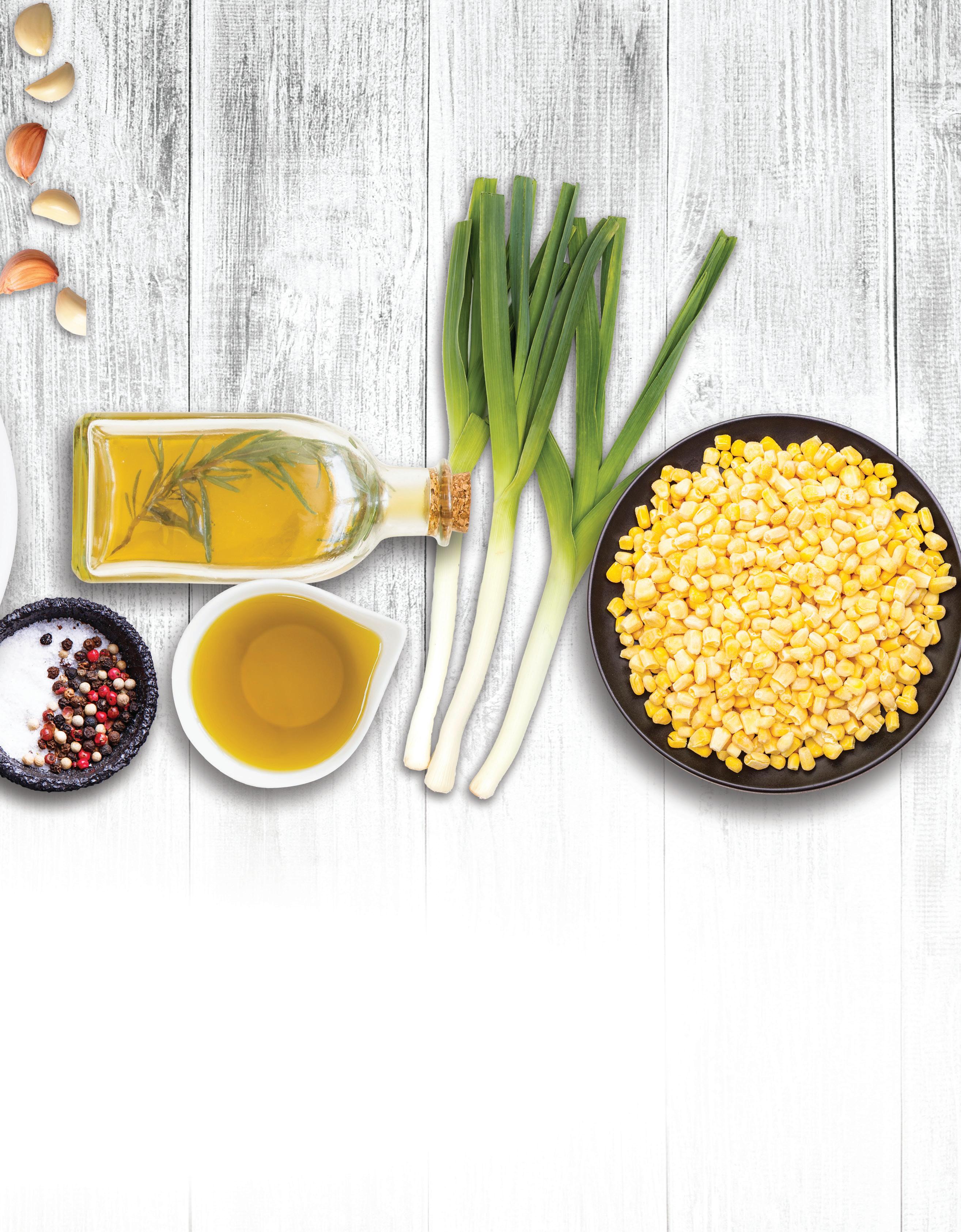
ferent challenges. “Seed provides genetic tools with which a plant can meet these challenges, and breeding plants in the environment of their intended use can deliver these beneficial genetics.”
She told me about another Participatory Plant Breeding project, a cucumber strain called DMR 401 that shrugs off downy mildew, a disease that is currently terrorizing cucumber growers in the East and Midwest.
The strain is so resistant that non-organic growers are seeking out DMR 401 seed. “Pesticide controls are losing their effectiveness against this ever-evolving pathogen,” she said. But breeders, with the assistance of Participatory Plant Breeding projects, are able to breed their plants faster than the pathogen itself can evolve and stay ahead of the disease.
As for that “Abundant Bloomsdale” spinach, Hubbard’s experience is more anecdotal, but equally impressive. Bred for its dark, glossy and thick leaves and slow-to-bolt temperament, it’s also so irresistibly sweet that last year her young son pillaged the spinach patch on a daily basis.
YUCCA UNIQUE
Joshua Tree National Park is a gem even during peak season
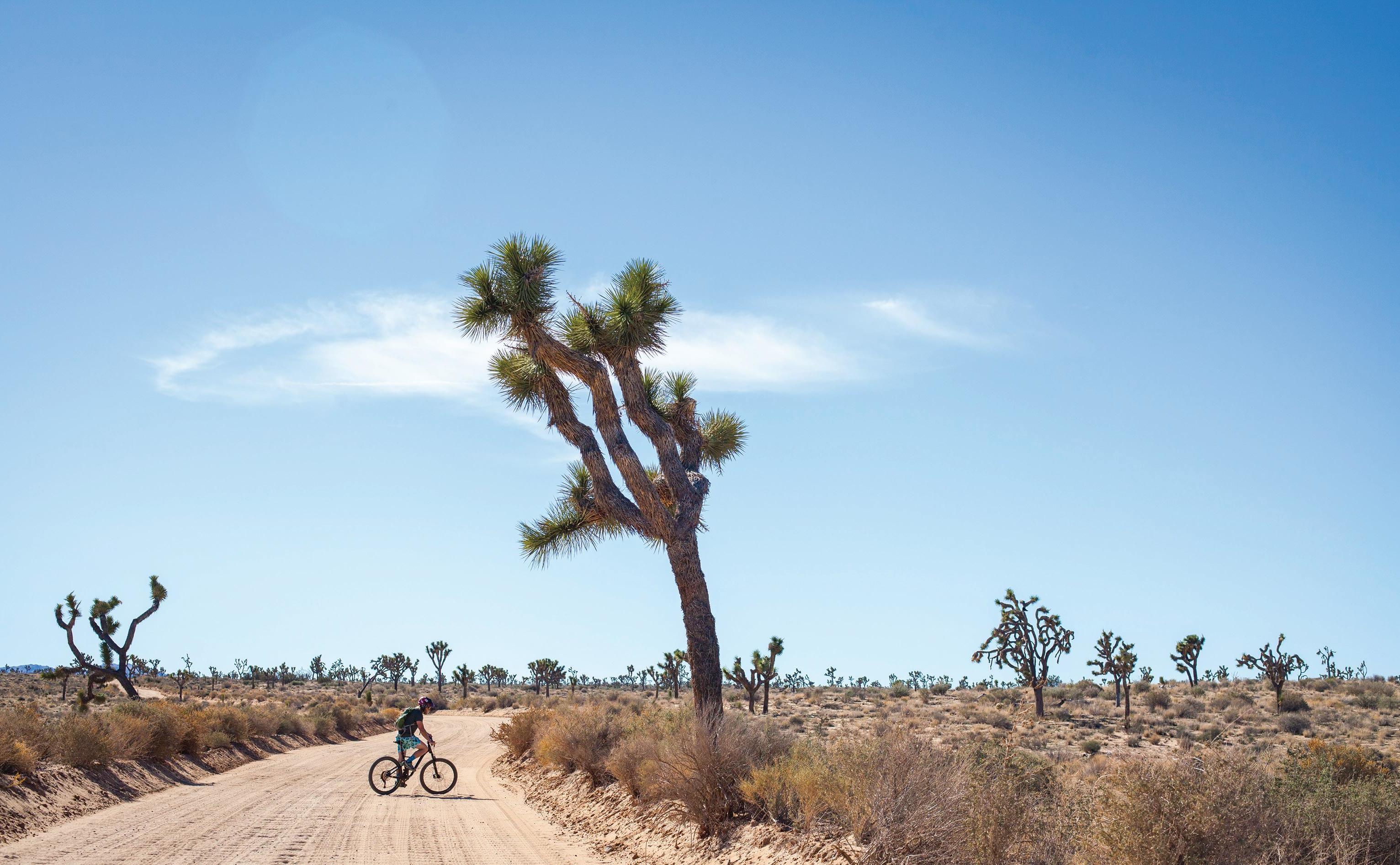
BY REBECCA CHAVEZ-HOUCK
Afew months ago, I purchased one of those wall maps of all the parks in the National Park Service (NPS). You know, one of those where you scratch off a decal when you’ve been to a park, which exposes a green pine tree underneath. As I scratched off decal after decal, I see how we’ve benefitted from living in Utah where we not only have six national parks, but also the benefit of living within driving distance of so many others, most a day or two from the Wasatch Front.
As I look at all of decals we scratched off our new map, I reflected on the incredible diversity of our country’s beautiful national parks, from the peaks of Glacier National Park to the hoodoos of Bryce and, how I’ve learned what makes redwood trees different from the giant sequoias.
We really enjoy these spaces and appreciate the NPS staff and volunteers who inform and educate us as we learn what makes each of these natural places special. We’re mindful, too, of the challenge that the NPS faces. It’s a paradox of plenty, where there have been so many efforts over the decades to encourage visitation, but now the NPS struggles to assure that its mission of conservation hasn’t been compromised by a groundswell of people coming to see the wonders of each park.
Since my husband and I now have fairly flexible schedules, we try to visit parks during their off seasons. An exception was our recent trip to Joshua Tree National Park (NPS.gov/jotr/index.htm) in California, which we opted to visit during the busy season, from October to May, in favor of the better weather. Perhaps best known for its iconic Yucca brevifolia, this national park is located in the desert east of Los Angeles at a nexus between the Mojave and Sonoran desert ecosystems, where the arid low desert meets a vegetated high desert. The park is quite hot in the summer months but wonderful to explore when the snow flies here in Utah. The days still get hot, and you need to keep yourself well hydrated, but the nights can get quite cold. We had frost on the interior of our RV’s skylight even with the insulation that we prop up there at night. There are no campgrounds with hookups so you can’t depend on electric heat of any sort.
We were there in October, and it was our first visit, which is surprising given how frequently we travel between Utah and California and the number of other national parks we’ve visited in the western U.S.
Cyclist at Joshua Tree National Park
Downtown’s Preferred Broker for All of Your Commercial Real Estate Needs


RETAIL | OFFICE | LAND | INDUSTRIAL | MULTIFAMILY
We stayed in the Jumbo Rocks Campground (NPS.gov/jotr/ planyourvisit/campgrounds.htm), and like most campgrounds in the park, it was available on a first come, first served basis (although the Black Rock and Cottonwood campgrounds do have reserved sites). True to its name, Jumbo Rocks provides an interesting landscape for a full moonrise, which we enjoyed until the bitter cold set in, and we jumped back into our RV to hunker down for the night.
While the campground had few vacancies, and we arrived at the start of the peak season, we enjoyed our time there because we didn’t feel overwhelmed by crowds that usually pervade more popular national parks. For example, while we arrived in late afternoon, we were able to easily find a place to park at the Keys View overlook, which is pretty breathtaking, although the poor air quality (courtesy of the Los Angeles Basin) does limit the extensive panoramas that a visitor could see there in years past.
We highly recommend taking the Keys Ranch tour (NPS. gov/jotr/planyourvisit/ranchtour.htm), which provides insight into the life of area homesteaders. It’s a National Historic Register Site. The park’s website notes that “the ranger-guided tour of the ranch includes the colorful story of the 60 years Bill and Frances Keys spent working together to make a life and raise their five children in this remote location. The ranch house, schoolhouse, store and workshop still stand; the orchard has been replanted; and the grounds are full of the cars, trucks, mining equipment and spare parts that are a part of the Desert Queen Ranch story.” Reservations are required for the tour, which runs from 9:30 to 11 a.m. Tuesday, Wednesday, Thursday, Friday and Sunday during the regular season of October through May.
Now that we’ve enjoyed so many of the more popular parks close to home, we are looking forward to visiting locations like Pinnacles, Channel Islands, Saguaro and Denali National Parks, ready to discover the natural wonders they offer. Plus, there are parks we hope to explore in the Midwest and eastern U.S. Someday, when we can take a month or two away from commitments at home, I especially would love to visit Acadia National Park in Maine and the Everglades in Florida. See you at the campground!
Keys View overlook
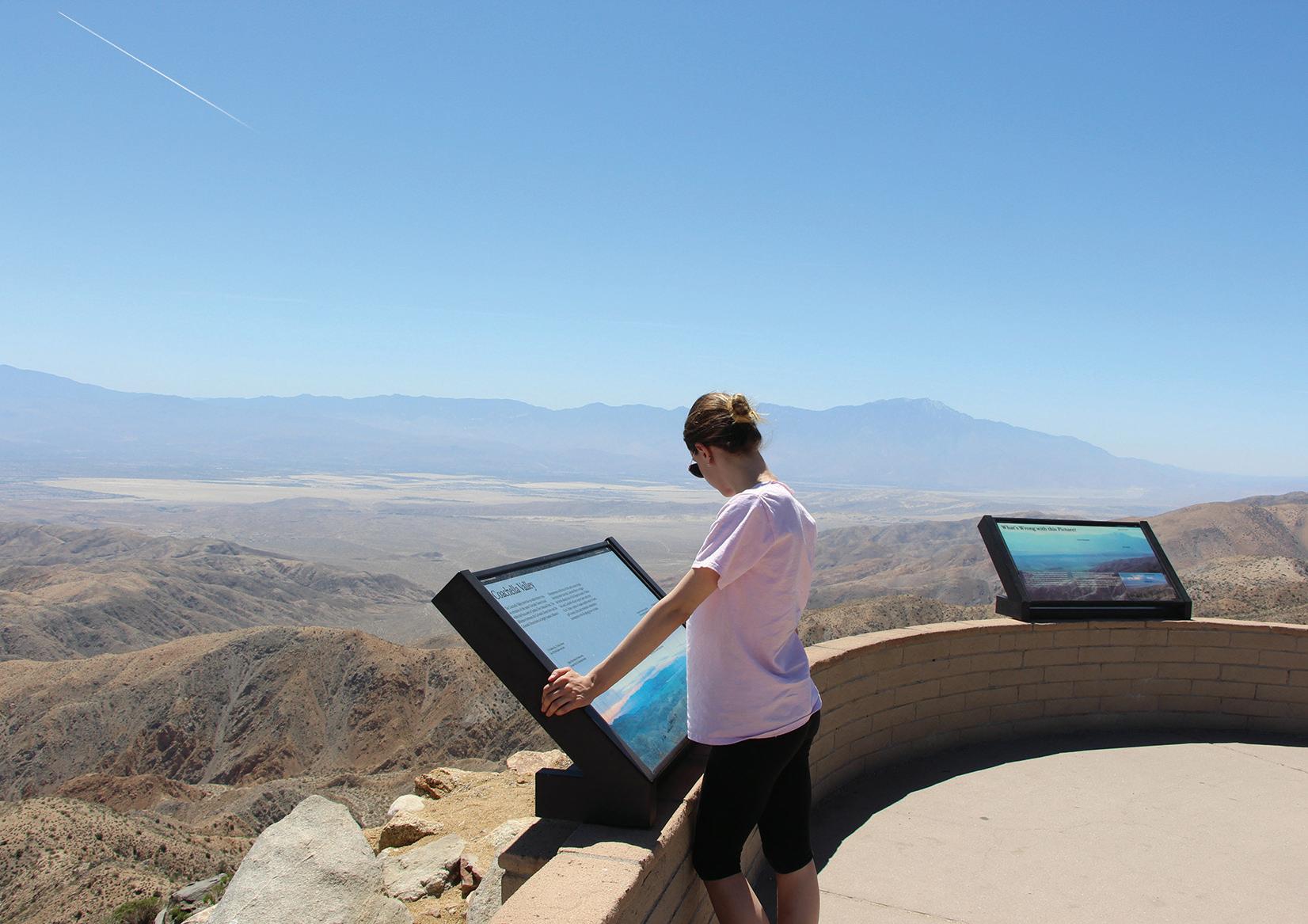
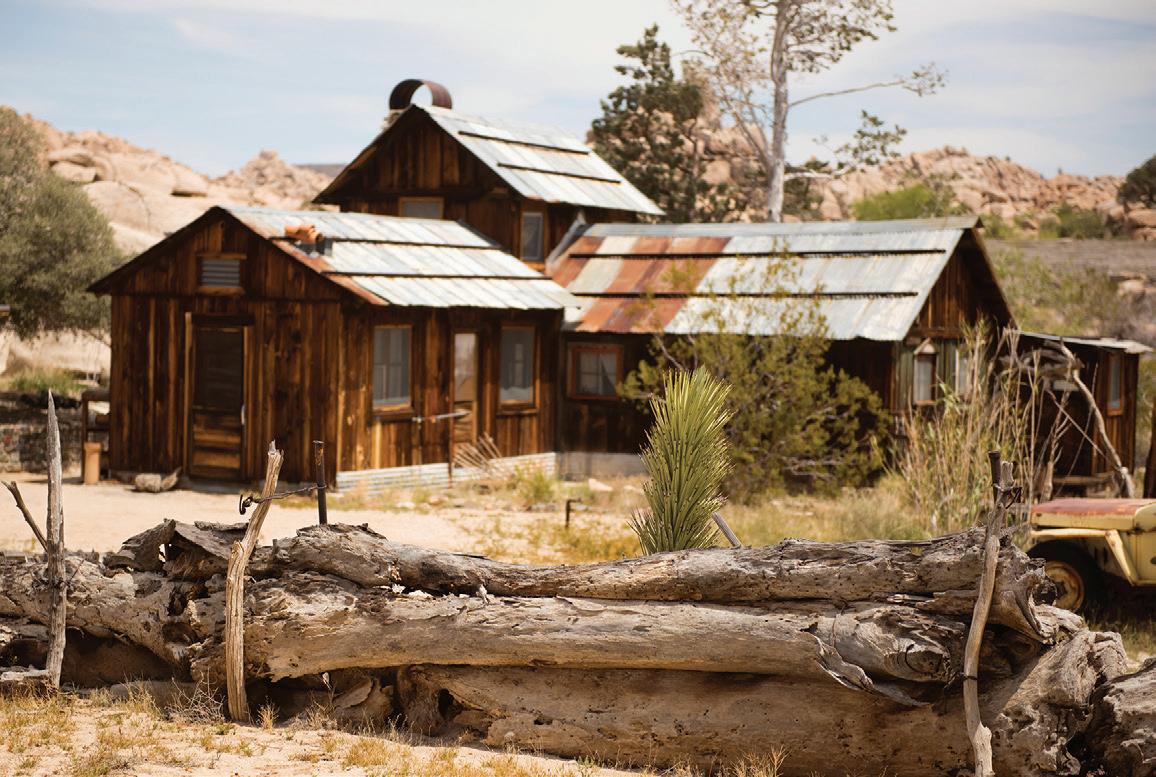
Keys Ranch house
The Milky Way seen from Jumbo Rocks Campground
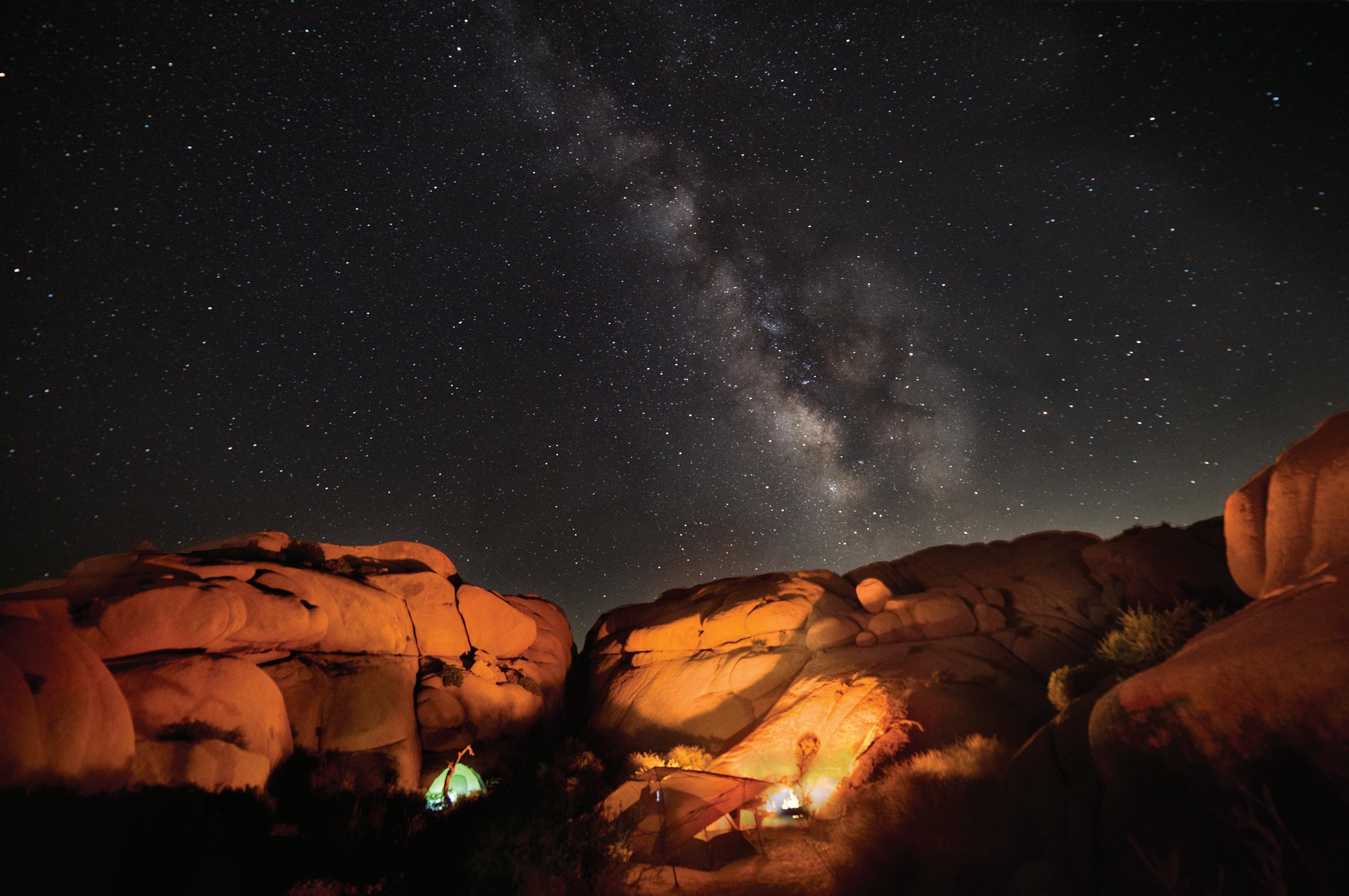
LAST LOOK
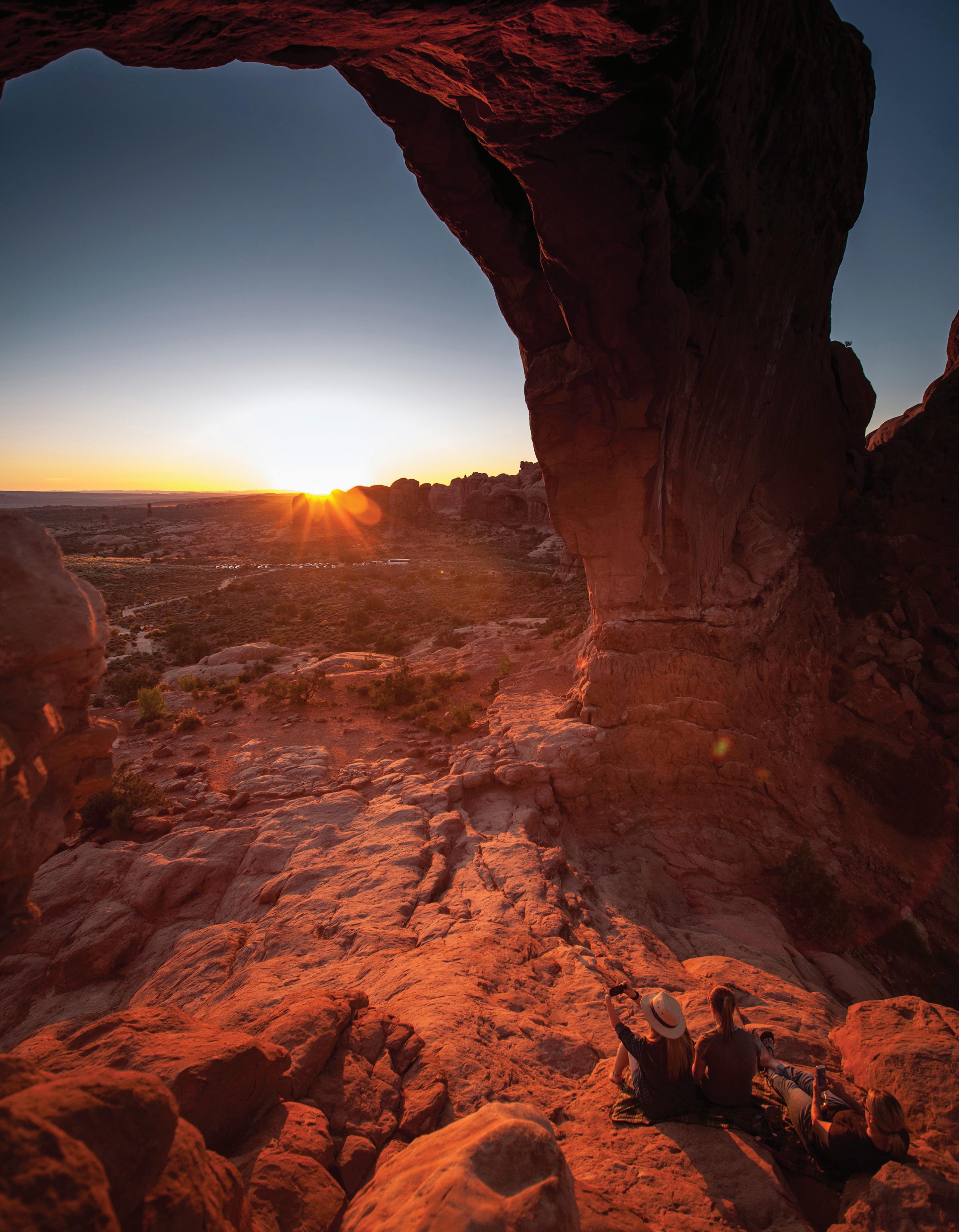
Arches National Park Photo by Joel Pilger on Unsplash
DEVOUR VOL. 5 NO. 2 • FEBRUARY 2019 • YEAR OF THE PIG FREE COPY
YEAR OF THE PIG
FISH TOSS: A RECIPE FOR PROSPERITY P. 21 CHINESE FOOD FEASTS P. 36
STATE STREET GEMS P. 24 MOMO MAKING P. 44
Devour Utah • february 2019 1
GET OUT | GET GOING | JUST GO
COLORADO DREAMING JOHN WESLEY POWELL’S RIVER ODYSSEY
GORGEOUS FLAMING GORGE
VOL.5 NO.6 • AUGUST 2019 FREE COPY
WET AND
August 2019 • Vamoose Utah | 1
FREE REAL ESTATE JULY 2019 FREE ISSUE CITY GUIDE 2019 1
We Are Utah Utah
MEET THE SPECIAL MEN AND WOMEN WHO MAKE UTAH GREAT
BEST OF UTAH 2019 | 1 The best spaces, places and faces in Utah real estate BEST OF UTAH Real Estate 2019 1 2019 FREE
A Utah Family Business

Offering media solutions for your digital, print and event endeavours.
The mining community of Copperfield was set in world famous Bingham Canyon, high in the Oquirrh Mountains. In 1906, the Saltas family joined those Copperfield residents in the steep hillside, shanty area, called Greek Camp.
Copperfield was home to thousands of melting pot immigrants including Greeks, Japanese, Mexicans, Germans, Swedes, Brits and many other ethnicities all bound to common American values of family, faith, education, hard work and community. They shared many good times, often tempered by the frequent bad times derived of dangerous mining work. Copperfield is now gone, scraped away by mining. But the Copperfield spirit remains alive in everything we do, from newspapers and magazines to events and digital services. We work hard for each other and for the large communities of readers—online and in print—who value honesty and stories told well.
We will keep telling stories—your stories—as long as people keep reading. And wouldn’t it be a shame if they didn’t read? We don’t think that will happen, so meanwhile, turn a page, or many pages, in one of Copperfield Publishing’s growing catalog of Utah award-winning publications. We are all the community of Utah. Enjoy.


